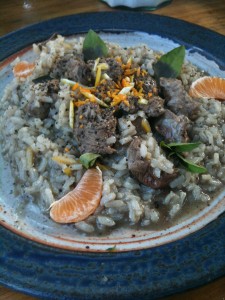Rice was introduced to the Italians and Spaniards by the Arabs during the Middle Ages. The weather along the Mediterranean Sea was ideal for growing the shorter grained rice, like the Arborio, and the merchants in Genoa, Venice and surrounding towns were able to profit from the rice growing industry that catered to the wealthy.

As interest in trade with the Mediterranean increased, others discovered the Italian delicacy and the demand increased for the short-grained rice. The Italian merchants’ profits grew as only the wealthy could afford the rice and other merchants took interest in this profitable product and began providing it as well. The increased availability flooded the market and lowered the price of the rice, making it more affordable.
Southern Italians had used the rice as a staple and slow-cooking (cooking over a low heat source for a long period of time) was predominantly used to prepare the daily meals. When slow-cooking the meals with the short-grained rice, it would combine the rice’s naturally occurring starch with rich stock or broth and create a creamy sauce; this practice would create risotto.
The recipe below utilizes the same principles of items found in southern Italy – lamb, citrus (lemons and oranges), olive oil, Arborio rice, and lemon basil. Although lamb is not commonly combined with citrus, but in this case it complements the risotto. Thus, creating a rich meal that tastes like it would be made for a special occasion, but is relatively easy to make.
Citrus Lamb with Risotto
Ingredients
2 lbs of lamb cubed
1 whole lemon (juice and zest)
1 tsp of orange zest
2 cups of lamb stock (veal or beef stock can be used instead)
1 cup Arborio rice (uncooked)
1 tsp of lemon basil, minced
1 tbsp olive oil
Sea salt (to taste)
Black pepper (to taste)
Remove the zest (skin) from the entire lemon and cut the lemon in half. You may use a zester (like a smaller cheese grater) or hand-shave the zest with a sharp knife; make sure you do not include the white pith (the area between the zest and the fruit). Once shaved, mince the zest and hold aside; the zest will provide most of the citrus flavor in this dish. You may do the same thing with an orange to get fresh orange zest.
Use a fork to pierce the lemon and squeeze the juice into a cup. The piercing will help remove the juice more efficiently. Make sure there are no seeds in the juice and set aside for later. Dispose of the lemon once the zest and juice have been harvested.
Add medium heat to a large skillet or pot and add the olive oil; add the lamb and a teaspoon of the lemon zest to brown slightly. Remove from the lamb from the pot and put aside, but leave the remaining fat and oil in the pan.
Place the pot back onto the medium heat and add the rice; brown the rice in the lamb fat and olive oil. Once browned, begin slowly adding the stock on medium heat while constantly stirring. Add the juice from the lemon to the rice. Add a lid to the sauce pan and continue to cook until both the rice has puffed up and a most of the stock has evaporated.
Add the lamb and the remaining lemon and a half teaspoon of the orange zest and lemon basil. The remaining orange zest and lemon basil will be used as a garnish prior to serving. Continue to cook the lamb and add salt and pepper to taste.
Serve family style on a single plate or bowl and sprinkle the remaining orange zest and lemon basil on top of the dish as a garnish. For the photo, small orange slices were added for additional color.
